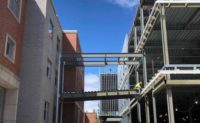It seemed like a good idea at the time.
When Creighton University planned its $100-million health education building in Phoenix, the goal was to marry the Nebraska college’s clean, modern aesthetic with a rawer Southwest look. Crucial to this design goal was an entrance tower covered in 4-ft slabs of desert rock.
“We wanted a local flair on the building that was very much Arizona sandstone,” says architect Ken Miller of Phoenix-based Butler Design Group. But the team quickly found that the best stone—a peach-colored sandstone striped in orange that also had the lowest cost and quickest lead time—was in a quarry in Jaipur, India.
The commitment was sizable: 140 tons of stone in six shipments to the Port of Long Beach, Calif., with each of the 900 pieces precut so workers could slide the slabs into the tower’s outer frame. Local stone mason Sun Valley requested that certain pieces be included in each container based on the anticipated installation sequence, says Carlos Gonzalez, senior project manager at general contractor Okland Construction. Every piece was numbered and reserved for a specific place on the tower.
Then the COVID-19 pandemic hit in spring 2020.
“What at the outset of the project looked like a phenomenal decision on behalf of cost and schedule ended up completely flipping the other way around,” Miller says.
“It’s already a fragile product,” he continues. “It’s difficult to ship anyway. With COVID and the factories shut down, we lost a lot of the safety factor we would have had in terms of quantity available and the ability to procure more.”
When the Indian quarry reopened with a skeleton crew, Okland began installing the stone’s anchoring system to prepare for it. To leave room for waterproofing, insulation and conduits, workers bolted 6-in.-long outriggers to the concrete tower, one every 4 ft, then attached aluminum rails to hold the stones. Workers then slid the 4-ft-high stones into the rails and locked them in place.
But another issue emerged: The product used to waterproof the tower beneath the stone could be exposed to ultraviolet light only for 60 days before its active ingredient began to degrade, Gonzalez says.
“We had to take that into account, and it became a waiting game—when would the stones arrive?”
Hard Choices
The first shipment of Indian sandstone for the Creighton tower arrived at the Port of Long Beach on Oct. 9, 2020. But due to pandemic disruptions and protocols, the trucks didn’t leave the port for about two weeks, Gonzalez says.
“We finally opened the crates and, lo and behold, some of the stone was broken, some of the stone was missing, and some of the stone was not what we were expecting,” he says.
This shipment was the result of decisions by the Indian supplier, which was trying to fill orders under nearly impossible conditions. When a stone broke during production, the supplier shipped the entire order without that piece, with an eye to delivering the missing pieces in the very last shipment.
“So here we are, just starving for these stones.”
—Carlos Gonzalez, Senior Project Manager, Okland Construction
“Obviously, if you’re trying to build something in a certain sequence, that’s not going to work,” Gonzalez says. Okland worked with the supplier to verify what was missing, then reshuffled its construction sequences to compensate.
As more shipments arrived, the team took stones reserved for later use and installed them right away. Okland also sourced full stone slabs for Sun Valley to cut by hand and literally fill the gaps.
Shipment delays continued throughout the project, says Susan Byram, vice president of design and construction for project developer Plaza Cos. A container shortage in December delayed the transports from India, while traffic jams at the port delayed unloading.
“So here we are, just starving for these stones. And they’re here, they’re literally just waiting off the coast, and we had to wait,” Gonzalez says.
Despite the challenges, Okland, Sun Valley and the rest of the team stuck to the project’s original schedule. The last stone shipment arrived in March, and workers installed the last piece in April. Construction on the entire project began in July 2019, and Creighton will receive the building at the end of April, with students attending the first classes in June.
Teamwork by Design
Rising 113 ft at the entrance to the seven-story building, the pristine, delicately striated sandstone shows no sign of its long, fraught journey across the globe.
Its warm tones offset the metal and glass exterior of the 143,000-sq-ft structure built for 900 students in Creighton’s medical, nursing, pharmacy and other health science programs. The building’s design required close collaboration between Butler, which designed the core and shell, and interior architect RDG Planning & Design in Omaha.
“RDG has done a lot of work for Creighton University, so they brought the Creighton aesthetic and know-how,” says Butler’s Miller. “We have expertise in being efficient and bringing projects in under budget, and we have experience with Plaza and the Phoenix market.”
Both design firms found subtle ways to break the university’s usual regimented look, such as incorporating exposed-concrete columns and polished concrete floors, Miller says. RDG also offset the building’s usual tight-edged ceilings with gaps that revealed the building’s inner structure and conduits.
The columns, especially, needed to look organic, Miller says. “We wanted the happy accidents you can’t plan ahead of time because concrete is a very natural, flowing material, it’s its own beast.”
In the project’s value-engineering phase, a single decision saved significant dollars, Miller says. The building’s design includes 40,000 sq ft of glass, and the original plans called for 14-ft, 8-in.-high panes. But those dimensions exceeded what the glass manufacturer could fit on its build tables. By trimming the some of the panes’ height by 8 in., Miller says, the team could get the glass at a third of the cost.
Working Closely, But Not Too Closely
As the Creighton building began to rise out of the ground, the 3.3-acre site also hosted two other construction projects—a 10-story parking garage and a condo building—all sharing the same spaces and road access. During its busiest days, 600-700 workers swarmed the site, says Jon Stelzer, Plaza senior vice president.
Placing the concrete for decks could only be done during the day, since the pumps couldn’t be operated at night without disturbing nearby condo residents. “We could get only 15,000 sq ft a day at most,” Stelzer says.
Managing a large number of workers on a tight site was especially challenging during a pandemic. Okland and Plaza installed plexiglass on everything from custom-designed lunch tables to two-person “cherry picker” buckets. Every two-person job required additional thought: When two workers lifted a heavy object together using straps, a third person stood nearby and held a piece of plexiglass between them.
The team also contracted with a sanitization company to respond whenever a worker fell ill—even when that worker operated the project’s tower crane and cleaners had to climb 120 ft to sanitize the crane’s cab.
While every aspect of the project was conducted remotely when possible, some meetings simply had to be done in person, Gonzalez says. Using the job trailer wasn’t an option, so Okland and Plaza built a little auditorium on site, equipped with a PA system, loudspeakers, microphones, a projector screen and folding chairs to allow superintendents to meet with foremen.
“The constant message: ‘OK, guys, let’s go meet in that safe environment,’ trickled down to individual workers and helped everyone stay safe,” Gonzalez says.








Post a comment to this article
Report Abusive Comment